|
Boat-Related Gizmos |

|
|
By Steve Lansdowne - Austin, Texas - USA |
Part of the fun of small boat construction for me is coming up with ideas for and constructing various related items. Some are knockoffs from items I’ve seen, while others are my own creation. Often such items are made of wood scraps from various other projects and assorted other items that I have saved over the years.
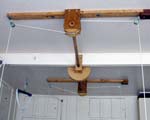 click images for larger views
click images for larger views |
Before I built my Whisp, I knew I wanted to store it in the garage but didn’t want to give up floor space. I recalled the metal pipe and cable boat lifts used to hoist boats out of the water for storage on the lake and figured I could come up with something similar for the garage that would hold a lighter boat. The result is a closet rod suspected from the ceiling (PVC pipe goes between it and the ceiling-mounted supports) which is turned in the center via a rope (not visible in photo) through a large wheel/gear and smaller gears at either end.
 I made a hand cranked winch, complete with small oak ratchets, and a locking cover for this to keep wandering hands off the boat. Prior to putting the boat up for the first time, I sat on a ladder suspended as the boat would be, figuring that if it would hold about 200 lbs of me and ladder, hoisting my 75 lb boat would be a snap. This hoist works great, pulling the boat far enough toward the ceiling that I can easily get my truck under it, and the boat is out of sight from the street as well. I made a hand cranked winch, complete with small oak ratchets, and a locking cover for this to keep wandering hands off the boat. Prior to putting the boat up for the first time, I sat on a ladder suspended as the boat would be, figuring that if it would hold about 200 lbs of me and ladder, hoisting my 75 lb boat would be a snap. This hoist works great, pulling the boat far enough toward the ceiling that I can easily get my truck under it, and the boat is out of sight from the street as well.
For the Wee Rob canoe I made a much simpler system of ropes and small pulleys to accomplish the same task.
 I knew I’d need a way to get each boat to the water, so I came up with a wood rack for the truck which doubles as a lumber rack. Atop this are removable front and rear roller assemblies constructed in part of iron pipe, old roller skate wheel bearings, foam pipe insulation, and some thin blue plastic hose that covers the insulation. I angled the black rubber rollers at the back to keep the boat centered, and the width of the front roller assembly is designed to keep the Whisp from being pushed too far forward when loading. I knew I’d need a way to get each boat to the water, so I came up with a wood rack for the truck which doubles as a lumber rack. Atop this are removable front and rear roller assemblies constructed in part of iron pipe, old roller skate wheel bearings, foam pipe insulation, and some thin blue plastic hose that covers the insulation. I angled the black rubber rollers at the back to keep the boat centered, and the width of the front roller assembly is designed to keep the Whisp from being pushed too far forward when loading.
 My canoe also sits easily atop this rack, though for a trip to Florida I made a smaller rack for the canoe that sits to one side of the truck rack, leaving the other side free for some lumber I planned to buy. Here electrical conduit and some swim noodle flotation make canoe loading fairly simple. The rear roller comes off once the canoe is loaded, leaving it level with the truck bed. My canoe also sits easily atop this rack, though for a trip to Florida I made a smaller rack for the canoe that sits to one side of the truck rack, leaving the other side free for some lumber I planned to buy. Here electrical conduit and some swim noodle flotation make canoe loading fairly simple. The rear roller comes off once the canoe is loaded, leaving it level with the truck bed.
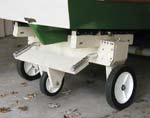 Once the boat is off the truck rack, it must get to the water. For the Whisp I made a three wheeled wooden boat cart with plastic wheels that utilized some aluminum tubing I happened to have from some medical equipment no longer needed. The third wheel keeps the cart stable until I load a boat on it. The two pieces that touch the bottom of the boat are padded with thick plastic hose slit up the middle, and the lower unit has a notch cut in it where the boat’s skeg fits. Once the boat is off the truck rack, it must get to the water. For the Whisp I made a three wheeled wooden boat cart with plastic wheels that utilized some aluminum tubing I happened to have from some medical equipment no longer needed. The third wheel keeps the cart stable until I load a boat on it. The two pieces that touch the bottom of the boat are padded with thick plastic hose slit up the middle, and the lower unit has a notch cut in it where the boat’s skeg fits.
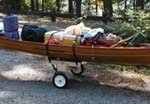 This cart was used to convert the canoe into a handy wheelbarrow on a camping trip, allowing me to easily move my equipment from the truck to a tent site not close to the parking lot. I’ve learned the hard way to securely fasten one’s boat to the cart when in use. This cart was used to convert the canoe into a handy wheelbarrow on a camping trip, allowing me to easily move my equipment from the truck to a tent site not close to the parking lot. I’ve learned the hard way to securely fasten one’s boat to the cart when in use.
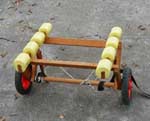 I later made a lighter collapsible canoe cart using recycled plastic tricycle wheels and some left over bungee cord and yellow swim noodle flotation, complete with folding stands that keep the cart level while I load the canoe. I later made a lighter collapsible canoe cart using recycled plastic tricycle wheels and some left over bungee cord and yellow swim noodle flotation, complete with folding stands that keep the cart level while I load the canoe.
Each of these carts floats, as I learned when I launched and couldn’t find the cart the first time I used it. It was stuck tight to the hull under the boat in the water. Each of these carts can be stored easily in the stern of the respective boat, thus saving a trip back to the truck once the boat is in the water were I to store the cart in the truck. It is fun to see the expression on peoples’ faces when they notice me rowing the Whisp with three wheels sticking up at the rear. The added weight aft even helps the boat’s trim.
 After the Tyvek house wrap Whisp cover I made got fairly dusty, I decided to make a more permanent cover for each boat. I found some very affordable marine fabric on the web and used plans from Sail Rite, along with sewing confidence gained from making two kit sails, to make a cover for each that is easy to install, keeping dust and bugs out of the interior of each boat when the are in storage. A simple draw string located a few inches below the sheer keeps each cover tight on the boat. I also made some sail covers to stow sails and spars in when they are in storage or traveling atop the truck rack. After the Tyvek house wrap Whisp cover I made got fairly dusty, I decided to make a more permanent cover for each boat. I found some very affordable marine fabric on the web and used plans from Sail Rite, along with sewing confidence gained from making two kit sails, to make a cover for each that is easy to install, keeping dust and bugs out of the interior of each boat when the are in storage. A simple draw string located a few inches below the sheer keeps each cover tight on the boat. I also made some sail covers to stow sails and spars in when they are in storage or traveling atop the truck rack.
 Wanting to engineer some flotation for safety into each boat, I turned to orange swim noodles lashed under the seat of the Whisp. Wanting to engineer some flotation for safety into each boat, I turned to orange swim noodles lashed under the seat of the Whisp.
I used slices of blue Styrofoam building insulation cut to fit the bow and stern of the Wee Rob, which is a sailing version. I leave these in when paddling also. I sewed covers for the Wee Rob’s flotation which have openings secured with Velcro so that the flotation can be removed for drying if the whole boat goes over, which has yet to happen. These units are lashed and bungeed into the boat and can be removed in a few seconds.
I also fabricated some cloth forward and aft “decks” for the canoe to help keep out water when sailing, along with some wooden pieces that bolt to existing thwarts to add some camber to these cloth decks. Thus far I’ve not done enough sailing to be able to tell whether these are really needed. A black nylon cord stretching under the gunwale along the sheer and a plastic latch secure these deck assemblies to the boat. (Chuck, thanks for the photo.)
A padded backrest makes paddling the Wee Rob more comfortable. A bungee holds the Whisp’s tiller and rudder down while allowing some “give” that won’t rip off the transom in case of running aground. Paddling one windy day on a narrow river with too much wind to sail, I wished for an easy way to get where I was going. Recalling a V sail I’d seen in Todd Bradshaw’s great book (Canoe Rig: The essence and the art), I fashioned one from Dacron material left over from my first sail. Easy to stow and thus to have ready quickly if needed.
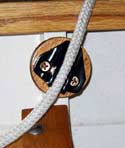 My Whisp’s sheet is held in one hand, tied directly to the end of the boom. With the tiller in the other hand, I sometimes have to resort to holding the sheet in my teeth to when hauling in or needing to use my hand for something else. I came up with a solution which I’ve yet to try on the water. I screwed a clam cleat to a round piece of wood which is secured to a frame loosely with one large screw. This unit pivots around the single screw and holds a line as needed temporarily. My Whisp’s sheet is held in one hand, tied directly to the end of the boom. With the tiller in the other hand, I sometimes have to resort to holding the sheet in my teeth to when hauling in or needing to use my hand for something else. I came up with a solution which I’ve yet to try on the water. I screwed a clam cleat to a round piece of wood which is secured to a frame loosely with one large screw. This unit pivots around the single screw and holds a line as needed temporarily.
 Finally, I decided to plan ahead in case I capsize and need to get back in. A small rope boarding ladder with wooden steps was the ticket. This will work with both boats, as they have scuppered inwales, but for the Whisp I can also use a notch in the back of the rudder as an additional step. For the Wee Rob I also came up with a paddle float utilizing some sealed cell stadium seating cushions secured in a bag made of leftover material, complete with a pocket into which the paddle blade can fit. These cushions come in handy for various things, such as resting the stern of a boat on when removing it from the truck rack if no grass is nearby. Finally, I decided to plan ahead in case I capsize and need to get back in. A small rope boarding ladder with wooden steps was the ticket. This will work with both boats, as they have scuppered inwales, but for the Whisp I can also use a notch in the back of the rudder as an additional step. For the Wee Rob I also came up with a paddle float utilizing some sealed cell stadium seating cushions secured in a bag made of leftover material, complete with a pocket into which the paddle blade can fit. These cushions come in handy for various things, such as resting the stern of a boat on when removing it from the truck rack if no grass is nearby.
Likely as not before long I’ll think of some other gizmo that will help improve my boating. I can hardly wait!

|